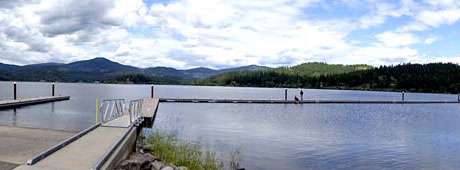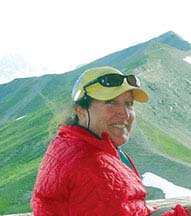No products in the cart.
Hauser—Spotlight

Trains, Tourists, and a Classic Lake
By Mary Terra-Berns
My maiden visit to Hauser, a quiet village huddled against a pretty little lake at the southern end of the Selkirk Mountains about a mile from the state boundary with Washington, involved a snake. Several years ago, when I was working for Idaho Department of Fish and Game (IDFG), I took a call from a panicked lady in Hauser: “I have a snake caught in my bird netting. You have to come get it. It’s as big around as a Mason jar.” Idaho doesn’t have native snakes that big. I paused for about ten seconds before responding, “Well, that’s a pretty big snake. I’ll probably need some help.” Her immediate response was, “No way, I’m not going to be there!”
Long before there was a village, Coeur d’Alene tribal members fished and collected camas bulbs on the south side of the lake, which was known as Sucker Lake back then. In the late 1880s, Sucker Lake was the favored resort destination for the well-to-do from Spokane and Coeur d’Alene. Vacationers and day-trippers traveled in railcars on the Northern Pacific Railroad, which traveled through here on its way to Montana. They disembarked at Hauser Junction to enjoy fishing—dozens of tiny fishing shacks lined the shore—swimming and picnicking.
Chris Jensen, one of the early pioneers who settled at the lake in 1887, realized his farm was a great place for a summer resort. To accommodate vacationers wanting to escape city life for a few days, he offered lodging and an excellent area for camping. Jensen rented boats to folks wanting to spend a little time on the water and for fishing. The August 14, 1903 edition of the Rathdrum Tribune noted, “It was largely by his efforts that the lake was stocked with bass by the government, and made a paradise for sportsmen.” The Tribune said perch were easily caught anytime and the bass fishing was “not to be equaled in Idaho.”
However, it wasn’t vacationing, fishing or farming that put Hauser on the map. It was the mining boom in the Coeur d’Alene Mountains. Gold, silver, lead, and zinc coming from the Coeur d’Alene Mining District and Silver Valley created a need for efficient and economical transportation. The iron horse gave rise to Hauser.
* * *
Daniel Chase Corbin was born in New Hampshire in 1832. On a pinball path to Spokane, he engaged in a variety of occupations, including surveyor, real estate agent, rancher, banker, storekeeper, mining investor, and railroader. In Montana, he met Samuel T. Hauser and several other investors while pursuing opportunities and together they worked on numerous mining-related ventures.
Corbin returned to the East Coast in 1876 to work with his brother Austin, managing the Manhattan Beach Railway in New York, but he continued to follow news about Montana. In 1886, at the urging of his good friend Hauser, now governor of Montana Territory, he returned to the Northwest to investigate building a rail line into the Coeur d’Alene Mining District from the Northern Pacific main line. Hauser had mining investments in Idaho and wanted to transport ore to his smelters in Montana.
This content is available for purchase. Please select from available options.
Purchase Only
Purchase Only

